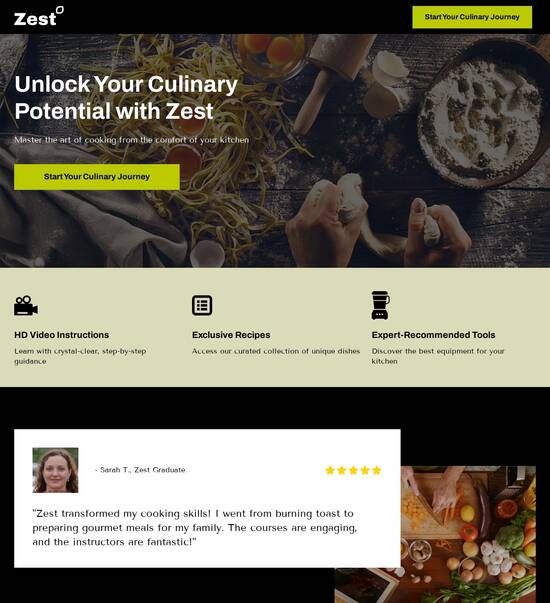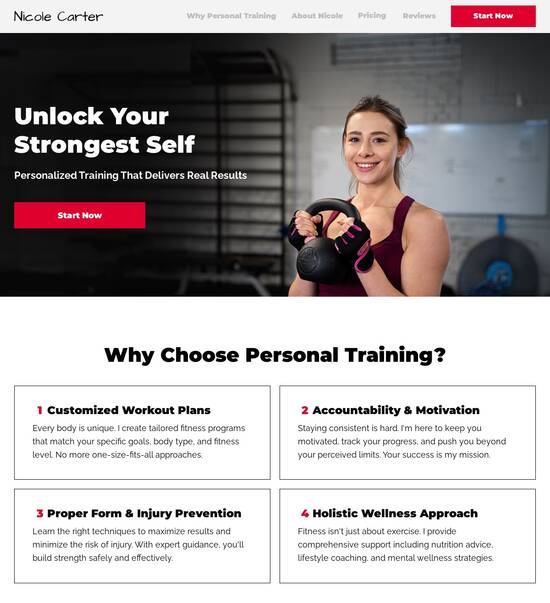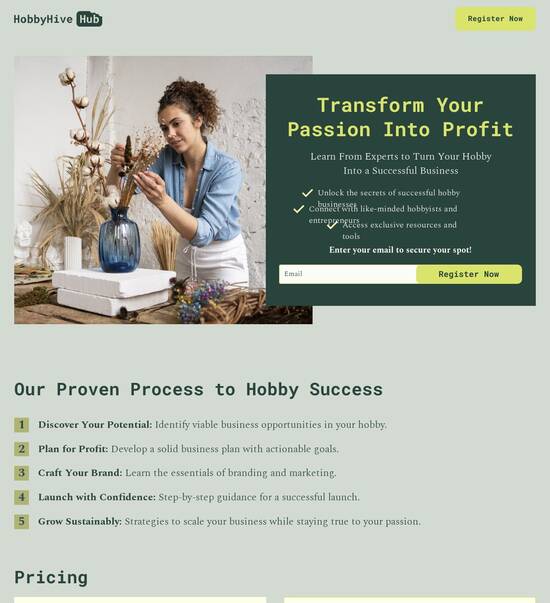
Static lead generation page templates
Use TemplateAbout template
Use static lead generation page templates and stay true to your brand identity. Resonate with your audience today.
Recommended templates

Easy to build without coding
With the intuitive drag-and-drop builder, anyone on your team can create high-converting pages without any knowledge of code or design. Make enhancements to your landing page with custom widgets using Javascript, HTML/CSS, or third-party scripts.

Multiple layouts for any industry and goal
Select from 500+ landing page layouts built to boost conversions across industry-specific scenarios. Customize them by adjusting fonts, adding images, and generating on-brand content with the AI assistant. Quickly scale with Instablocks® and Global Blocks that you can save, reuse, and update globally.

Loads fast and looks polished on any device
Every template is responsive, which means they present professionally on any device and load blazingly fast with our Thor Render Engine. You can also power them up with Google AMP technology to deliver an unparalleled mobile experience and drive higher conversions.

Robust analytics & experimentation
Get real-time updates and reporting across all your devices, showing the number of visitors, conversions, cost-per-visitor, and cost-per-lead. Launch AI-powered experiments, run A/B tests, and use heatmaps to analyze user behavior, then optimize your landing page to maximize conversions.







Easy to build without coding
With the intuitive drag-and-drop builder, anyone on your team can create high-converting pages without any knowledge of code or design. Make enhancements to your landing page with custom widgets using Javascript, HTML/CSS, or third-party scripts.
Multiple layouts for any industry and goal
Select from 500+ landing page layouts built to boost conversions across industry-specific scenarios. Customize them by adjusting fonts, adding images, and generating on-brand content with the AI assistant. Quickly scale with Instablocks® and Global Blocks that you can save, reuse, and update globally.
Loads fast and looks polished on any device
Every template is responsive, which means they present professionally on any device and load blazingly fast with our Thor Render Engine.
Robust analytics & experimentation
Get real-time updates and reporting across all your devices, showing the number of visitors, conversions, cost-per-visitor, and cost-per-lead. Launch AI-powered experiments, run A/B tests, and use heatmaps to analyze user behavior, then optimize your landing page to maximize conversions.
All the features you need to build lead-generating landing pages
Explore more featuresLearn how to build top-performing landing pages for any goal
FAQs
Leading the way in building high-performing landing pages





Create a static lead generation page template with Instapage
Static lead generation page templates are crucial for optimizing digital marketing campaigns in today's competitive marketplace. Instapage empowers marketers to leverage high-converting templates that are designed to capture leads effectively. By utilizing these templates, businesses can accelerate their marketing initiatives while maximizing their return on investment (ROI).
Step 1: Choose the right template
Instapage offers an extensive library of over 100 conversion-focused templates that cater to different industries. When selecting a static lead generation page template, consider the following:
- Industry alignment
- Choose a template that reflects your industry’s aesthetic and messaging to resonate with your target audience.
- Call-to-action (CTA) prominence
- Select a design where the CTA stands out, ensuring users know what action to take next.
- Mobile responsiveness
- Opt for templates that are optimized for mobile devices as a significant percentage of users browse on their phones.
Step 2: Customize your content
Once you have chosen your template, it’s essential to tailor the content. Focus on creating targeted messages using the following tips:
- Dynamic text replacement
- This feature allows you to customize messages based on the visitor's location or search terms, making the experience more relevant.
- High-quality visuals
- Incorporate appealing images and videos that support your brand message and engage visitors.
- Clear, concise language
- Write in a straightforward manner that communicates your value proposition without jargon.
Step 3: Optimize for conversions
After customizing your lead generation page, focus on optimization to improve your conversion rates. Consider these strategies:
- A/B testing
- Utilize Instapage’s built-in A/B testing features to identify which elements convert better.
- Heatmaps
- Analyze heatmaps to understand where users click most often and which sections need refinement.
- Analytics integration
- Implement tracking tools to measure your campaigns’ performance and identify areas for improvement.
By following these steps, you can create a powerful static lead generation page template that enhances your campaign’s effectiveness.
Ready to boost your lead generation efforts? Start using Instapage today to take full advantage of expertly designed templates and robust optimization tools. Sign up now for a free trial!
People also ask about Static lead generation page template
The power of static lead generation page templates: transforming user engagement through effective design
Understanding static lead generation pages
Static lead generation pages are crucial tools in the digital marketing toolkit, designed specifically to capture potential customers' information. Their primary purpose is to encourage visitors to provide their contact details in exchange for value—such as a free eBook, webinar, or product demo. This gives marketers a way to cultivate relationships with prospects, turning them into leads and, eventually, customers.
The importance of these pages cannot be overstated; they serve as the cornerstone for building an email list and nurturing leads through targeted content. Unlike other website pages that might serve a broader audience, static lead generation pages focus on a singular message aimed at converting visitors. This laser focus helps maximize visitor engagement.
When comparing static and dynamic pages, the distinctions are evident. Static pages are simple HTML files that display the same content to all users every time they are loaded. Conversely, dynamic pages pull content from a database and can change based on user interaction, preferences, or other variables. Static pages offer benefits such as faster loading times, ease of use, and higher reliability, making them ideal for lead generation.
Designing for success: the role of visual appeal
Aesthetic design plays a pivotal role in successful lead generation. First impressions matter, and a well-designed landing page can significantly influence visitor behavior. Visual elements—such as colors, images, and fonts—can evoke emotions and guide users toward desired actions. Colors can incite feelings ranging from urgency to trust, emphasizing the importance of carefully chosen color schemes.
Best practices include maintaining a balanced color palette and using typography that enhances readability. It's essential to ensure that visual elements contribute to the overall flow rather than distract the user. Furthermore, the layout of the page should prioritize usability. Intuitive navigation is vital for keeping visitors on the page and guiding them toward completing the form to capture their information.
Whitespace is another crucial design element. An uncluttered design creates a clean, professional look, helping users easily locate critical information without feeling overwhelmed. This combination of visual strategy and thoughtful layout can maximize engagement, ultimately leading to higher conversion rates.
Essential components of an effective static lead generation page
Crafting compelling headlines is the first and most critical step in engaging your audience. The psychology behind effective headlines can significantly impact conversion rates, as they must capture attention and convey the value of what you're offering. High-converting headlines often address the visitor's pain points or highlight the benefits of the offer.
Use numbers in headlines, e.g., '5 Secrets to...'
Incorporate a sense of urgency, e.g., 'Limited time offer!'
Make it benefit-oriented, e.g., 'Learn how to...'
Strategic use of images and videos enhances user engagement, providing visual context to the offer presented. When optimizing media for fast loading and responsiveness, it's crucial to understand how visual content can aid in user retention. Images should be high-quality yet not overly large, ensuring they enhance rather than hinder loading times.
Form fields are where the magic happens, capturing user information tactfully. Best practices include limiting form fields to essentials to balance information collection with user experience. The fewer barriers you place between the visitor and the submission, the higher your conversion will likely be.
The impact of user experience on conversion rates
User experience is pivotal to maintaining high conversion rates. Given the dramatic rise in mobile users, ensuring mobile responsiveness is no longer optional. Statistics reveal that over 50% of web traffic now comes from mobile devices, underscoring the necessity for landing pages that function effortlessly across all screen sizes.
To ensure compatibility, it’s advisable to use a responsive design that adapts to different devices. Simplifying navigation and minimizing load times can drastically improve user experience and retention on mobile devices. Mobile users are often impatient, and they expect pages to load quickly. A delay of even a few seconds can result in significant abandonment rates.
Loading speed itself is a critical factor that impacts user engagement. Tools like Google's PageSpeed Insights can help assess loading times and provide actionable suggestions for improvements. By optimizing images, minimizing code, and leveraging browser caching, marketers can ensure that their static lead generation pages load efficiently and retain visitors.
The data-driven approach: leveraging analytics for optimization
Analytics tools are invaluable for tracking visitor behavior, providing marketers with critical insights to enhance lead generation effectiveness. Key metrics to monitor include bounce rates, conversion rates, and user pathways on the page. By understanding how visitors interact with different elements on the page, marketers can optimize content placement and redesign aspects to improve performance.
A/B testing is a powerful method to experiment with design and content variations on a static lead generation page. This approach allows marketers to understand which elements resonate better with users through controlled tests. For example, changing a headline or altering form placements can reveal preferences that significantly improve conversion rates. Real-world examples have shown that even minor adjustments can lead to dramatic improvements in lead capture.
Regularly analyzing analytics data and running A/B tests opens avenues for continuous improvement. Staying attuned to the evolving preferences and behaviors of your audience is critical for maintaining relevance and staying competitive.
Integrating email marketing for enhanced engagement
The integration of static lead generation pages with email marketing strategies creates a powerful synergy that enhances overall engagement. By strategically placing forms and calls to action, lead generation pages can significantly augment email marketing campaigns. This complementary approach helps marketers build a robust email list, facilitating targeted communication with leads.
Techniques for seamless form integration with email software are vital for maximizing capture efficiency. When visitors provide their information, they should feel as if they’re part of a personalized journey. Using auto-responder email sequences encourages ongoing engagement, nurturing leads until they’re ready to convert.
An effective email capture strategy requires understanding visitor motivations for opting in. Building enticing lead magnets—like exclusive content or discounts—can incentivize sign-ups. Offering value upfront ultimately leads to higher conversion rates and long-term customer loyalty.
Customer-centric design: meeting the needs of your target audience
Identifying customer personas is essential for creating content that resonates with your target audience. Customization plays a significant role in increasing the relevance of your landing page. Developing detailed personas based on demographics, preferences, and pain points allows marketers to hone in on what truly matters to their audience.
Tailoring content to enhance engagement can transition visitors from casual browsers to leads. A well-defined value proposition should address the specific needs and concerns of your personas. By using personalized content strategies, such as dynamic text replacement and targeted visuals, marketers can improve engagement and conversion rates.
Transforming data into action: using visitor insights for page enhancement
Analyzing visitor data is vital for making informed decisions about enhancing your static lead generation pages. Employing tools like heatmaps can provide insights into user behavior, helping identify which areas of the page attract attention and which are overlooked. This information informs strategic adjustments that align with visitor interests.
Creating a feedback loop is essential for continuous improvement. Regularly gathering customer feedback allows marketers to refine landing page design, demonstrating responsiveness to user expectations. Staying adaptable to shifting consumer preferences ensures that your lead generation efforts remain effective, no matter the changing digital landscape.
Innovative tools and technologies changing the game
Emerging tools for landing page design are revolutionizing how marketers approach their static lead generation pages. Various platforms provide effortless design options, allowing marketers to leverage enhanced features without requiring coding skills. Artificial intelligence is also making its mark by analyzing user behavior and optimizing page layouts for maximum effectiveness.
Drag-and-drop builders for easier page design.
AI-driven tools for content optimization.
Real-time analytics for immediate feedback.
Successful case studies illustrate the effectiveness of static templates. Companies that implemented these templates experienced significant improvements in lead generation metrics, providing valuable lessons about best practices and optimizations that others can learn from.
Future trends in lead generation page design
Predictions for the evolution of static landing pages suggest that a continued push toward more personalized and user-friendly experiences is on the horizon. As user behavior changes, embracing innovations like augmented reality or enhanced interactive features may become commonplace. Shifting demographics and preferences will also shape future design practices.
Preparing for this future requires adaptation and a willingness to learn. Staying updated with industry trends and consumer behavior feedback will be vital. Marketers should be prepared to iterate continuously on their strategies, ensuring long-term success in engaging their target audiences and converting leads.
Ready to skyrocket conversions?
Supercharge your ad campaigns with high-performing landing pages
Get started














